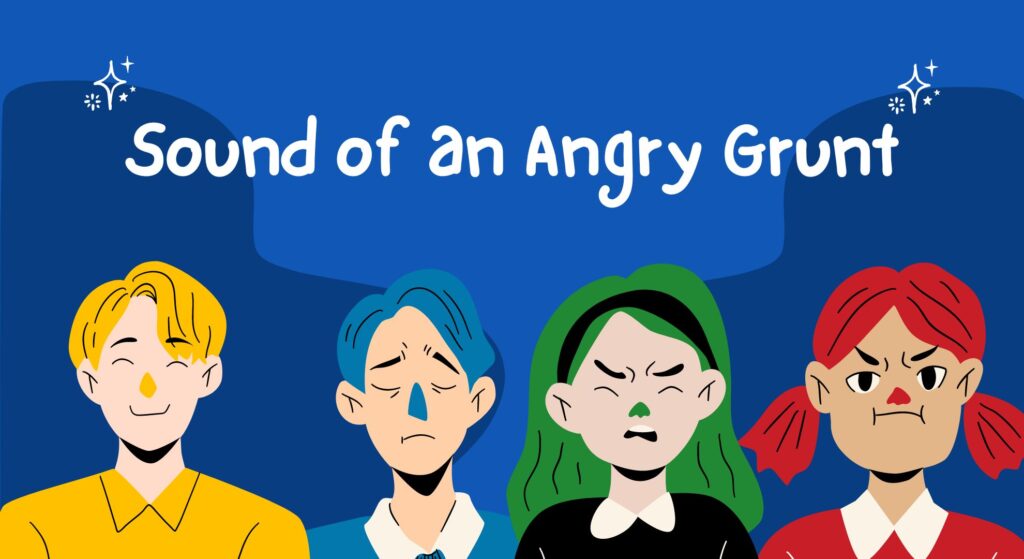The sound of an angry grunt can convey a range of emotions, from frustration to annoyance. It’s a sound that many people have heard but may not fully understand. This article will explore the nature of this sound, its meanings, and its impacts in various contexts. We will break down the components of an angry grunt and its implications in both human interactions and animal behaviors. By the end, you’ll have a deeper appreciation for this seemingly simple expression.
What Is an Angry Grunt?
An angry grunt is a low, guttural sound that people often make when they are upset or irritated. It can come in many forms, from a quick exhalation to a drawn-out noise that reflects deeper feelings. This sound serves as a non-verbal cue that communicates emotions without using words. Grunts can also vary in intensity and length, which may indicate the level of anger or frustration someone is experiencing. For instance, a short grunt might express mild annoyance, while a longer, deeper grunt could suggest more significant frustration.
Why Do People Make Grunting Sounds?
Grunting is a natural response to emotions. It allows individuals to express feelings without verbalizing them. People often grunt when they are tired, frustrated, or annoyed. This sound can be a way to vent emotions without escalating a situation. Grunts serve as a form of release, allowing people to cope with feelings of anger or irritation. In some cases, grunting can also signal to others that they need space or that they are not interested in conversation.
The Psychology Behind Grunting
The sound of an angry grunt has psychological roots. It can serve as an outlet for pent-up emotions. When people are stressed or angry, they may not always find the right words to express their feelings. Instead, they resort to physical expressions, such as grunting. This sound can help alleviate some tension, acting as a quick release. Additionally, research shows that non-verbal expressions, like grunting, are often more effective at conveying emotions than words alone.
Grunts in Animal Behavior
Animals also use grunting sounds to communicate their feelings. For example, many mammals grunt to express annoyance or aggression. Pigs, for instance, are known for their loud grunts, which can indicate everything from excitement to displeasure. In the wild, these sounds can serve as warnings to other animals. Grunting can signal that an animal is feeling threatened or needs space. Understanding these sounds can help us better interpret animal behavior and the emotions behind those sounds.
Grunts and Social Interactions
In human social interactions, grunting can play a vital role. People often use these sounds in group settings to convey their feelings to others. For instance, during sports events or competitions, fans may grunt in frustration at a bad play. This shared sound can create a sense of unity among spectators. On the other hand, grunting can also indicate dissatisfaction or anger within a group, leading to conflicts. Recognizing these sounds can help individuals navigate social dynamics more effectively.
Cultural Interpretations of Grunting
Different cultures interpret the sound of a grunt in various ways. In some cultures, grunting may be seen as rude or disrespectful, while in others, it might be a common form of expression. For example, in some indigenous cultures, grunting can signify agreement or understanding among community members. Understanding these cultural nuances is essential for effective communication across different groups.
The Impact of Grunting in Communication
Grunting can have a significant impact on communication. It can either enhance or hinder understanding between individuals. For instance, if someone grunts in frustration during a conversation, it might signal to the other person that they need to change the topic. Conversely, if someone grunts in agreement, it can affirm that they are on the same page. Being aware of these sounds can help improve interpersonal communication and reduce misunderstandings.
Benefits and Drawbacks of Grunting
| Benefits | Drawbacks |
|---|---|
| Quick emotional release | Can be misinterpreted as aggression |
| Non-verbal communication | May offend or annoy others |
| Helps to express frustration | Lacks clarity in meaning |
| Can create group solidarity | Might escalate tension |
Alternatives to Grunting
While grunting serves its purpose, there are other ways to express frustration or anger. Verbal communication, for example, allows individuals to articulate their feelings clearly. Using “I” statements, such as “I feel frustrated when…” can help convey emotions without relying on non-verbal cues. Engaging in physical activities, such as exercise, can also provide an outlet for pent-up emotions. Finding healthier ways to express feelings can lead to better emotional well-being.
In summary, the sound of an angry grunt is a complex form of communication. It serves various purposes in both human and animal interactions. While grunting can express emotions effectively, it also has its limitations. Being aware of the nuances behind this sound can enhance our understanding of emotions and improve our communication skills. By recognizing when we grunt and what it means, we can better navigate our social interactions and express ourselves more clearly.



